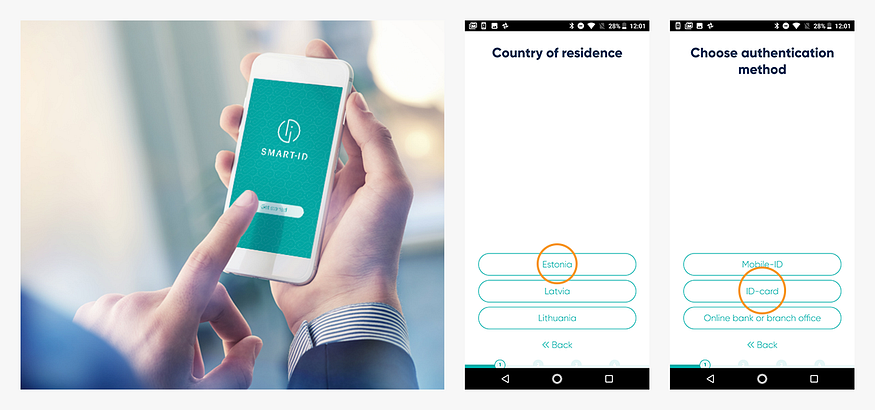

Starting an Estonian company online has never been easier. At Unicount, we’ve reduced it to a simple three-minute task. While working with Estonian company founders over the past two years, we’ve noticed the same questions come up a lot immediately after their Estonian company is registered.
So we put together this list of ten of the most useful things to know.
1. Estonian company registration certificates are available online for free
You can download your new company’s registration certificate and shareholder data in English straight away from the Estonian e-Business Register. These documents are often necessary when applying for a business account with financial institutions, merchant account providers, or any other service. Downloading certificates is free and takes just a minute or two.
For the registration certificate, go to the Estonian Business Register, search for your company name, open your company details view and then select the tab “Registry card”. You can see the current information with automatic translation to English that is available for download as a PDF. Here is the Unicount manual with more details.
For the shareholder’s certificate, browse to the tab for ‘General and personal data’ and click on the PDF text button. This opens a print with all the available details including information about the field of activity, founders, shareholders, and beneficial owners that are missing from the registration certificate. Here is the Unicount manual with more details about shareholder information.
From the “Articles of Association” section in your company details, you can also download your articles of association. Official articles on the register are always in Estonian so for the unofficial English version you need to find them in the formation application .bdoc container file if you used a foreign language when registering the company.
If you need certified documents, then the only way to certify a registration certificate or articles of association is by using an Estonian notary. Besides these three document formats, there are no other official incorporation certificates in Estonia. You can contact notaries directly or use a service provider as an intermediary to help with this process.
The Estonian Business Register does not issue certified paper documents in Estonia because, well, nobody needs them! That’s the great thing about being a digital nation.
2. You can use Smart-ID on your phone to log in and sign
Estonia’s digital ID cards may be famous around the world, but most Estonians use their mobile phones for regular digital signing instead. This is also available to e-residents as an app called Smart-ID, which you can set up with your e-resident digital ID.
You can then leave your card and reader at home and don’t have to pull out a laptop every time you want to digitally sign. It even works if your digital ID card is lost or expired. Read more about Smart-ID.
Most Estonian government e-services now accept Smart-ID and since November 2018, it has been a Qualified Electronic Signature (QES) — the highest digital signature standard in the EU.

Photo from SK ID Solutions AS
3. Protect your personal contact details from scraping sites
You’ve just registered a new Estonian company but before you can even announce the launch of your business to the world, your company has already started receiving spam emails. This is a common complaint among e-residents and international residents of Estonia. This happens because your company email is listed publicly on the Business Register, which means it can be bought or scraped by spam marketers. This is why all Unicount clients registering a company through the API service will have their public email replaced with Unicount email automatically. The court sometimes blocks that so it may not be available for all clients.
To be fair, Estonia has a very transparent business environment, which is a good thing, so public company email is just one part of that, even if the spam can be a bit annoying. However, there’s a nifty little solution that is commonly used by tech savvy Estonians looking to reduce unsolicited commercial emails — using the government-provided spam free email address.
The only thing worth noting is that you cannot activate spam-proof email before your company is registered. So we would recommend using a temporary email when registering a company, but be sure to have one that you can actually access to see if the court has approved your application.
If you were required to publish your phone when registering a company you should know that you can also delete it from the register as having an email is enough. The faster you do it the less time for scraping sites to collect your data.
4. Estonian company has no tax ID or alternative trading name
Some countries with less synchronised registers use a variety of unique identifiers for different purposes such as tax and social security etc. In Estonia, you only have an 8-digit company registration code and your 11-digit personal identity code (isikukood). These work well for all institutions and services in Estonia.
This also means that you do not need to apply for any tax number to start trading in Estonia.
If you are requested to present your unique taxpayer number (sometimes called TIN) somewhere else in the world, then there is no other number to present besides your registration code. If you are being asked for a VAT registration number then this is also not mandatory to have in Estonia (until your company exceeds certain thresholds; see below) and therefore should not be compulsory to access any service inside or outside of Estonia.
Similarly, some countries require you to register any alternative trading names used besides your legal name. Not in Estonia. There is generally no special requirement to register alternative trading names, but be sure not to infringe on someone’s registered trademark or other rights prescribed in law. Besides the national trademarks, watch out for EU trademarks as they are valid in all member states including Estonia. Your registered company name does not grant you any trademark rights and there is only some protection for your legal name. You can check trademarks from the Estonian Patent Office website.
Note that Estonian law requires you to list your company name and registered address on your website. This is also just good practice though in order to maintain high standards of transparency in business and trust among customers.
5. You can register for VAT in Estonia only when necessary
Registering your company for VAT in Estonia becomes mandatory when your company makes more than €40 000 of taxable income in a calendar year for which the place of supply is Estonia. Determining the place of supply is something to speak with your accountant about.
Before reaching that threshold, registering is optional. Whether you benefit from registration depends on the VAT amount on goods and services you buy and also whether your clients are individuals or VAT-registered businesses. Being VAT registered means monthly tax reporting and most probably monthly accounting fees in Estonia.
If you decide to register for VAT right after formation, you can order the service from Unicount via the Client Dashboard or you can do it yourself by following the instructions in the Unicount support article. Even if you register on your own we do not recommend submitting the monthly VAT reports on your own though. This is something a qualified accountant in Estonia should do. Also, any late filing might result in a 100 euro late filing penalty by the Estonian Tax and Customs Board and the possibility that your VAT registration could be revoked.
Please note that you could be liable for VAT in other countries where you have a permanent establishment or have goods and services delivered. Determining these potential tax liabilities is something to check with your accountant or tax advisor. Unicount does offer tax consultations that are available even before you sign up for our services with your new company in Estonia.
6. Estonian company’s main activity code does not limit your scope
It is mandatory to pick one field of activity code when registering a limited company. Some clients ask if they can register more than one and the answer is no. Having a main activity code does not limit your business activities though as long as you are getting involved in other business lines that do not require a license or registration with authorities. You can read more about these on the e-Residency website.
You can’t change your activity (called EMTAK) code in the Business Register later on. The main area of activity will be automatically determined based on which activity generated the most income according to your last annual report.
Also, your company can invest in all asset classes available to investors in general even if it is not registered specifically as an investment company (activity code being 64301). Some trading platforms might have no support for Estonian limited companies or legal persons though.
Engaging in finance-related business models with your limited company is a potential regulatory minefield and you need to consult with experts before starting. For example consumer credit, e-money, or ICO emissions. Regulations tend to be similar for financial institutions all over the EU.
7. Annual report needs to be submitted even if the company was dormant
Some of our clients have asked if they need to submit annual accounts if their companies have been dormant and no sales revenue was generated in the previous financial year. The short answer is yes, you still need to submit annual accounts for each financial year. The standard financial year in Estonia is calendar year 1 January to 31 December. Annual accounts are called “annual report or majandusaasta aruanne” in Estonia and there is no simplified dormant accounts regulation in Estonia.
Technically e-residents can submit annual accounts online via the Estonian Business Register. Unicount generally does not recommend it if you are not familiar with Estonian GAAP (Generally Accepted Accounting Principles) and want to record any items such as expenses, assets, or liabilities even if your company generated no sales. If you still feel strong then here is the Unicount manual for it. By following these instructions you would be able to submit micro-company annual accounts with no recorded economic activity.
The screenshots and instructions only apply for micro-company annual accounts (mikroettevõtja) and therefore cannot be used for any other type of businesses not qualifying as single physical person shareholder micro companies. If you cannot choose in the selection of standard “Mikroettevõtja” then probably you are not one according to Business Register information. This then means that you need to manually insert your Estonian GAAP or IFRS-compliant accounting principles and most probably you do not know how to do that.
By the way, Estonia still expects you to submit your annual accounts in the Estonian language even if the figures input can be done in the English user interface. Translation into English is only additional information data that the company chooses to publish. All accounting principles and activity reports need to be in Estonian language. Unicount provides both dormant and active company annual accounts service to its virtual office clients.
8. You can add new shareholders and investors online
Until recently any share transaction required a visit to an Estonian notary or complicated legalised documents with government-issued apostille to certify that a potential shareholder has given someone who is physically in Estonia a power of attorney for a share transfer in a notary bureau.
Luckily by now, there are four alternative ways to add new shareholders.

Photo by Egert Kamenik
The first method is using an e-notary, which was launched in February 2021.
Estonian notaries have launched an e-notary service so that company e-residents can transfer shares to another e-resident online, instead of at a notary office in Estonia. You can read more about this on the e-Residency blog. All other aspects of the process remain the same so you will still need to book and pay for a notary, but at least you don’t have to fly to Estonia or get an attorney involved.
Managing your own shareholder list
The Estonian Parliament changed the law at the request of the startup sector so that shares can now be transferred to a new shareholder at the responsibility of the parties involved if the company’s articles of association approve this. This option can only be added to the articles of association if it is unanimously agreed by all existing shareholders. The law came into force on 1 August 2020.
However, for this to work your company will need to have a share capital of at least 10 000 euros that has been fully paid in. That helps startups but is not useful for most e-residents and other Estonian small business owners unless they want to deposit 10 000 euros.
Using the NASDAQ depository service
Your company can register its shares with Nasdaq CSD, as an alternative to the Estonian Business Register managing your shareholder list. The restriction here though is that all the shareholders need to have a securities account at an Estonian bank. That can be a tricky requirement for even the most experienced venture capital fund investors if they are non-residents.
So what if your new shareholder doesn’t have an Estonian securities account and none of the other options are suitable for you? Well, there is one more option that we recommend to micro-companies with limited budgets.
Issue new shares of your Estonian company online
There’s one more way to add a new shareholder to your Estonian company and it’s surprisingly simple. We like to keep things simple here at Unicount so we’ve tried it ourselves multiple times with our own businesses and we are aware that it has successfully worked for other startups.
It is much easier because you don’t transfer any existing shares to your new shareholder. You simply issue new shares online directly to them instead. Therefore this involves no notary and no NASDAQ depository.
As outlined in Estonia’s Commercial Code, you will need to produce a digitally signed shareholders’ resolution that outlines the planned new share allocation with the details of all the shareholders. You’ll also need proof of their payment for this previously agreed share from your company’s banking service provider. You can read more in Unicount’s handy guide.
9. No need to have a minimum share capital of 2500 euros
Estonian limited company (osaühing) required a minimum share capital of 2500 euros until 31 January 2023. This was an investment in your company that could then be spent on developing your business. When you start a company in Estonia through the Unicount formation service, your default share capital is 1 euro starting from 1 February 2023. The management board needs to certify that this 1 euro has been deposited to the company bank account, but no need to prove it until the amount is not more than 50 000 euros. This is great news for e-residents who may struggle to get a bank account in Estonia for depositing share capital before the company is actually registered.
Until 31 January 2023, Estonia also had a system that allowed you to postpone this investment when registering a company as a natural person founder. The only catch was and is that your company can’t pay out dividends until your share capital has been registered, but you can start trading and even pay out salaries before then.
If you do not have an accountant yet you can also wait until your first annual report to register your postponed share capital of 2500 euros if you registered your company before 1 February 2023. The reason is the legal requirement to declare any changes in company share capital by submitting an income tax declaration by the 10th of the next calendar month.
Your company’s monthly income and social tax declaration (TSD) Annex 7 would need to include any share capital contributions and dividend distributions. When liquidating the company, your paid-up share capital can then be paid out to the shareholders tax-free.
Unicount’s detailed guide for registering your postponed share capital of 2500 euros online via Business Register can be found on our blog. You would first need to register your postponed share capital and then potentially you could reduce it to 1 euro cent with the next submission. However, you should have a good reason for doing so if you already have a registered share capital of 2500 euros.
Please note that you should distribute dividends only after annual accounts have been accepted by a shareholder resolution and submitted to the Business Register.
10. You need to keep your expense documents for accounting
In some countries, your accountant might be okay with bank statements only.
Not in Estonia.
You will learn quickly that until you provide receipts and purchase invoices the amounts paid from the company account are considered to be a director’s loan. In other words, your liability to the company. It is better to know it before you start spending company funds.
If you are not registered for VAT in Estonia you might otherwise learn after 18 months of business freedom that your accountant is not willing to submit your annual accounts with expenses recorded as you imagined but instead with a huge director’s loan account balance. Searching for year-old receipts is a nightmare for a busy entrepreneur.
A fun fact is that the Estonian Accounting Act requires you to keep the documents for 7 years after the end of the financial year.

Photo by Renee Altrov
To go more into detail, Estonian VAT law § 37 prescribes what information needs to be on the invoices for them to be valid. VAT law applies to Estonian entities even if they are not yet registered for VAT in Estonia. Some of the required fields, for example, are the serial number and date of issue of the invoice; the name and address of the issuer with VAT number (if registered for VAT); the name and address of the acquirer of goods or the recipient of services; the VAT number of the acquirer of goods or the recipient of services (if registered for VAT); the name or a description of the goods or services; the quantity of the goods or extent of the services, and the list continues with some more specific requirements such as references to reversed or zero-rated VAT clauses for cross-border sales.
This is also the reason why US-based expense management apps work well and European ones look so complicated, due to EU VAT regulations demanding a lot of information from source documents. Here is a sample invoice from the Estonian expense management and invoicing tool Envoice.
And finally…
Note that e-Residency is not tax residency. While some companies belonging to e-residents do pay taxes in Estonia, others don’t. It all depends on whether another country can fairly claim that you have a permanent establishment in their country, such as a fixed office or a place of effective management (location of the company board). For personal tax residency, this won’t change unless you actually live in Estonia for at least 183 days over the course of a period of 12 consecutive calendar months. You can learn more about personal tax considerations and if you have any doubts at all about your tax obligations then consult a qualified accountant.
This is important to know because if Estonian accounting firms detect that your company’s tax liabilities are outside Estonia they could potentially refuse to onboard you as they cannot help in other jurisdictions with mandatory tax reporting and accounting. Paying for a professional accounting and tax service in other countries might change your monthly business expenses drastically.
If you have no permanent establishment and place of supply elsewhere, your company is below the Estonian VAT registration threshold and does not employ people in Estonia, you can enjoy submitting annual accounts once a year with the help of a professional accountant in Estonia. This would keep you compliant while maintaining a low annual cost base.
Thanks for reading
We hope you enjoyed this article. If you have more questions check out Unicount’s extensive support articles.






